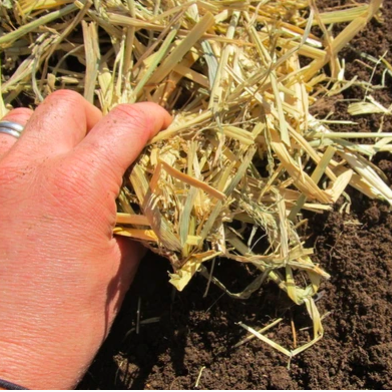
The Benefits of Mulching in Fall
Although the active gardening season is now behind us, there is still gardening to be done, with an eye to the next growing season. Storage crops should be harvested (we've been rushing to get our final harvesting done with the first threat of frost this weekend); flower bulbs, garlic, wildflowers, and hardy greens should be sown now for spring; and the garden in general can be cleaned up and readied for the next crop cycle. Mulching is one essential task you can do to prepare beds for spring planting. Although often done in spring, covering your garden with a big, protective mulch blanket in fall has many benefits. Fall mulching also works great with a gardener’s schedule. Removing sowing, weeding, watering, and harvesting from the to-do list opens a nice, relaxed window for projects like mulching. That won’t be the case in the spring!
Tender perennials, garlic, and even flower bulbs use mulch to keep their root system insulated from the harshest temperatures and also to retain moisture, which is limited in winter. In empty beds, mulch is great for suppressing weeds, adding trace minerals to the soil (with leaf mulch), and cushioning the soil to reduce compaction. It also extends the active season for beneficial microorganisms and worms by keeping the soils warmer longer.
Tips for applying mulch in the fall for easy bed preparation in spring:
 Choose your mulch: Take advantage of natural rhythms if you can, and use an ideal, abundant, and free mulch source: fallen leaves. If leaves are unavailable, corn cobs, woodchips, sawdust, and straw are good options.
Choose your mulch: Take advantage of natural rhythms if you can, and use an ideal, abundant, and free mulch source: fallen leaves. If leaves are unavailable, corn cobs, woodchips, sawdust, and straw are good options.
Break it down: if using leaves, corn cobs, or fine brush, it is most effective when broken down or shredded into small pieces. This will help it break down quicker over the winter, so it does not interfere with spring plantings. A shredder is the easiest way to break down these materials. Other potential options are to push a lawn mower over the leaves a few times or to run over the materials back and forth with a car.
Apply: after removing all remaining plant debris and weeds from your bed, and amending the soil if needed, shovel mulch directly onto the bed. Rake it out to a layer of three to five inches and consider weighing down with a little compost sprinkled over the top.
In spring: If the mulch has not decomposted much and you have already applied compost in the fall, all you need to be ready to sow is to clear just the space where the seeds will go (either thin rows or individual holes). If the mulch has nearly completely decomposed, work it into the soil, and apply new compost and mulch before sowing.






